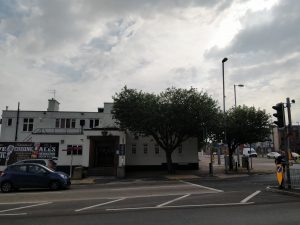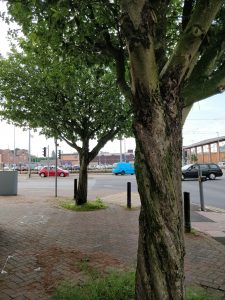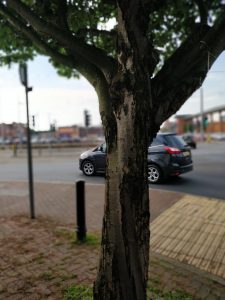Beeston Tree Heritage
“A Culture is no better than its woods” W. H Auden
In this heritage themed issue of Trees Of Beeston (TOB), I want to introduce the importance of trees into our everyday valuing of civic heritage. We are very fortunate in Beeston to have so many street trees and indeed trees in the front and back gardens of private properties that function to enrich the quality of our environment: enable all manner of animals to live alongside us for our betterment (hello insects! Hello birds!). It is important to remember that many of these trees have been planted, maintained, and cared for by civic custodians in previous decades for our everyday enrichment, and that we have a duty to pass that careful and thoughtful tree heritage forward. For the many buy-to-let property owners in Beeston who could potentially see tree maintenance as simply felling, I would urge you to think again. Well maintained coppiced or pollarded trees (maintained by specialist tree surgeons) can give not only unique landscape features, improved vistas and reduce the worst side effects of extreme weather conditions, but also retain values to properties because trees make places more habitable, more desirable. If you have a mature tree in or near your property, consider looking into Tree Preservation orders. I have recently noticed I have bats in the row of trees that make a wee hedgerow at the back of my garden. Little pipistrelles. They eat the gnats as well as the increasing numbers of mosquitoes that have been hatching in the heat of the summer and with such extreme weather patterns more likely to increase in the coming years, I am more than happy to have my Bat box up to encourage nature’s insect repellent into my garden and outdoor area.
I am particularly thankful to The Beeston Civic and District Society who have campaigned and worked so hard over four decades to maintain the diverse and beloved tree heritage we have. While a number of notable and beloved trees have been lost, the society has campaigned and enacted tree-planting programmes to ensure a quality of life for the humans living, working and passing through. To keep bees in Beeston (and indeed all manner of vital insects, pollinators, animals) it remains important that the trees we love in our public spaces and along our streets.
For more information about the Beeston Civic and District Society, see https://beestoncivicsociety.org/about/our-history/
Trees Of Beeston #2 The White Lion Linden/Lime Trees.
By Dr Jo Norcup
The Lime / Linden Trees outside The White Lion Pub at the junction of Middle Street and Station Road are not just useful markers in the landscape, nor simply shelter from the elements after vacating the pub after last orders. These lime trees provide magical roosting space in their branches for the beloved Beeston Pied Wagtails whose flock in mini-murmurations last winter provided a fleeting nature spectacle as the birds in their tens (I stopped counting at around 60 birds), eddied and swooped between the site of the flattened Beeston Fire Station and car park that provides temporary seasonal playscape during holiday seasons: Christmas Fayre Houses of fun to bouncy castles, sand pits and ride in the summer at Beeston on the Beach. In-between times, it is home to wild poppies and rudely dismissed wild flowers (“weeds”) that enable passing pollinators to feed between there and the magnificent lavender flowers that stand at the front of the White Lion and The Star Inn (these planters are now lovingly watched over by the street art depiction of Michael Elphick as Boon when Central TV used the location for filming the 80s TV drama, but I digress). Before this site is developed and the temporary exposed skyscape around Beeston Central tram interchange is again infilled with concrete, pay attention this autumn for the Pied Wagtail mini-murmurations. At dusk. Be patient as you will be rewarded with the privilege of watching the wee nodding monochrome birds gathering and readying themselves for roosting. Their pre-roosting flights can be watched in and around the trees that border Beeston Square, but for better visuals of their swoopings, head for the lime trees outside the White Lion Pub
Lime Trees or Linden trees (Tilia) are a popular and highly diverse family of trees found in the northern hemisphere of the globe. They are not related to the citrus tree that produce the lime fruits found in Mediterranean climates. The name Lime derives from Middle English, lind meaning yielding, as the trees were prized for their adaptability and use for carving, model-making, and sculpture. The non-specified Lime/Linden trees outside The White Lion have dense, palm-sized, green heart-shaped, leaves that are immediately recognisable during the spring and summer time. Their trunks are tight and the branches interweave, lattice-like as they go upwards to create branches that canopy to provide much prized dense shade on a hot day. What makes them utterly distinct are the white with a hint of lime green flowers that appear in the spring throughout the summer which eventually grow small spherical fruits. Lime flowers secrete a sweet nectar, attracting a diverse array of pollinating insects, especially butterflies and bees. These trees are highly prised by beekeepers for the amount of pollen they produce. For a town with ‘Bees’ in its name, it is apt then that here in Beeston we learn to love and cherish these amazingly giving trees. In addition to the benefits gifted to insect life, humans over the centuries have also come to regard the Lime/Linden flowers. Herbalists value their medicinal benefits as dried and then steeped in hot water, a lime-flower infusion as tea has been noted to give health benefits for those suffering from a cold, coughs, fever or infections. Limeflower tea has also been valued for its diuretic properties. Lime trees flowers in the spring bring a sweet, rich warm inviting smell that might be a challenge to discern above the car fumes and everyday human noise and bustle, but you will be able to sense it next spring. You will get a soft subtle waft up your nose, a sweetness and lightness. The linden/lime letting you know longer days the dark days are over, and the light is returning.


